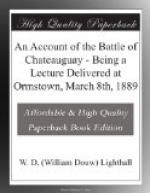4. Mr. Thomas Baird, merchant, of Ormstown, remembers well a Mr. Laberge, a very old man, who had been one of the soldiers on picquet duty at Ormstown, when the Americans invaded this country, in 1813. Laberge said that the Canadians stationed at this point were few in number, and were posted near the mouth of the Outarde, along the North bank of the Chateauguay, and also along the creek which now runs through the village of Ormstown. There the Canadians were taken by surprise. Those who escaped, retreated to De Salaberry’s headquarters a few miles down the Chateauguay.
Laberge also said that some of the Americans who were killed in the battle of the next day, October 26th, were buried on the bank of the creek, to which reference has been made. In this connection it is interesting to relate that while excavations were being made a few years ago for a roadway through this bank, the remains of five or six men were unearthed. The U.S.A. military buttons, the belt buckles and the bayonet found in their grave removed any doubt that these were the remains of American soldiers. This last item was kindly given the writer by Mr. Chas. Moe, who assisted in making the road.
5. The ford over the Outarde, by which the Americans crossed, still remains and is known as the “American Ford.” It is about three miles west of Ormstown village. The annual Spring floods have undoubtedly changed it somewhat. Both banks of the river shew the place to be a coarse gravel bed. By the addition of more gravel they easily made a fine roadway.
6. Mr. John Symons, who came to the Chateauguay River in 1828, and has lived in its vicinity ever since, and who at the time of writing resides in Ormstown, informed the writer that Alexander Williamson, one of the earliest settlers, used to say that what is spoken of as the battle of Chateauguay, is greatly magnified. Williamson regarded the Americans as a great lot of cowards who were glad to take advantage of the slightest opposition to return home.
7. Mr. James Brodie, a retired farmer, residing in the village of Ormstown, and who also was well acquainted with Alexander Williamson, states that Williamson was about twelve years of age when the battle was fought and was not present at the fight, but what he knew of it he had learned from others.




